While the Toronto Maple Leafs have gotten off to a — let’s call it — less-than-inspiring start, one of the narratives that has sprouted up of late is that head coach Mike Babcock neuters the team’s offense. Let’s look at the facts.
Over the last three seasons, the Leafs have led the league in scoring chances at 5v5 (over 400 more than the second-place Penguins!) as well in total 5v5 goals. The power play, before this season, has been about as elite as possible. Once they acquired some real talent, Babcock has been overseeing the most explosive offensive team at 5v5 and on the power play over a three-year stretch. That’s the two most noteworthy phases of the game on offense, and it’s a large sample.
It came at a price, though. The Leafs often played a long-bomb, blow-the-zone style of game. Forwards shot the zone hoping for scoring chances — and honestly, it worked, offensively at least. But when Springtime came around each year, the Leafs started to struggle, soon followed by first-round exits in the playoffs, where that style of hockey is no longer as viable. Fans have complained each year about this style of game and how it’s not suitable for winning playoff series.
The power play also struggled down the stretch, failing to make adjustments to the opposition taking away Mitch Marner as he ran the power play from the half-wall without shooting the puck.
That brings us to this season. The team has gotten away from the blow-the-zone style of hockey that everyone complained about and often failed them in the playoffs. They parted with the coach who ran the power play. The offense is adjusting to changes that — remember — everyone pined for after years of being lights out statistically. In some cases, this is necessary – we don’t see teams going far in the playoffs that cheat defensively to the degree that the Leafs have over the years.
In other cases, the power play just needs to be straight up better and it is probably a case of overthinking at this point. Running power play breakouts that involve a drop pass every single time is tired and predictable. Power play issues aside, if Babcock’s big crime is getting away from the forwards cheating out of the zone – which seems to be their only notable change in style – so be it. I can live with that.
Otherwise, stylistically and in terms of what they are allowed to do offensively, to my eye, it looks exactly the same. The team is tenth in goals per game and sixth in shots on goal per game. At 5v5, they are ninth in scoring chances for per 60. Some of the rhetoric out there is basically suggesting this team has the clamps placed on them, and yet they are top ten across the board in the notable offensive categories at evens.
At 5v5, their shooting percentage is 15th, which will likely rise in time. John Tavares’ injury obviously didn’t help their cause, either. Some of it is that the team just has to execute better, too. Realistically, though, if you’re looking at this roster and the structure they have in place and suggesting the coach has been neutering offense — I just don’t see it. They’ve been torching the league for years and he’s made one notable change at 5v5, one most fans were clamouring for.
The power play, though? That’s a legitimate gripe at this point.
Notes
– In the first period of Leafs – Flyers, Kasperi Kapanen had a 2v1 and the pass wasn’t there, so he tried shooting for rebound. Elliott read it and was able to kick the rebound away from danger, but it was the right idea. When Babcock first came to Toronto, the Leafs used to do this a lot – shoot for rebounds off the rush and drive the net. They have really gotten away from that over the seasons, but it’s a nice wrinkle to the offense and it can be very difficult to defend.
While on that Kapanen shot, though: The idea was nice, but he shot for rebound with a slapshot, and that’s just making life more difficult than it needs to be. If you “pass it off the pad,” the actual strength and power behind your shot is almost irrelevant at this level – you need to place it properly about six inches off the ice around the goalie’s upper ankle/knee area when they are in the butterfly. Any goalie will tell you when it’s executed properly, they are essentially helpless.
– The Leafs’ six defenders receive a lot of attention and backlash for the team’s defensive struggles, but routinely, the forwards make fundamental errors and don’t help out in coverage. Here’s the Flyers’ first goal on Saturday. You can see in the first clip that Andreas Johnsson is just a hair behind Philippe Myers:

And yet, on the backcheck, his awareness that Myers is his man is almost non-existent down the ice. The Leafs have two defensemen back as well as Matthews coming back – it’s effectively a 3v3 and Myers is pushing up ice. He’s wide open and knows it. He’s already calling for the puck in the neutral zone.
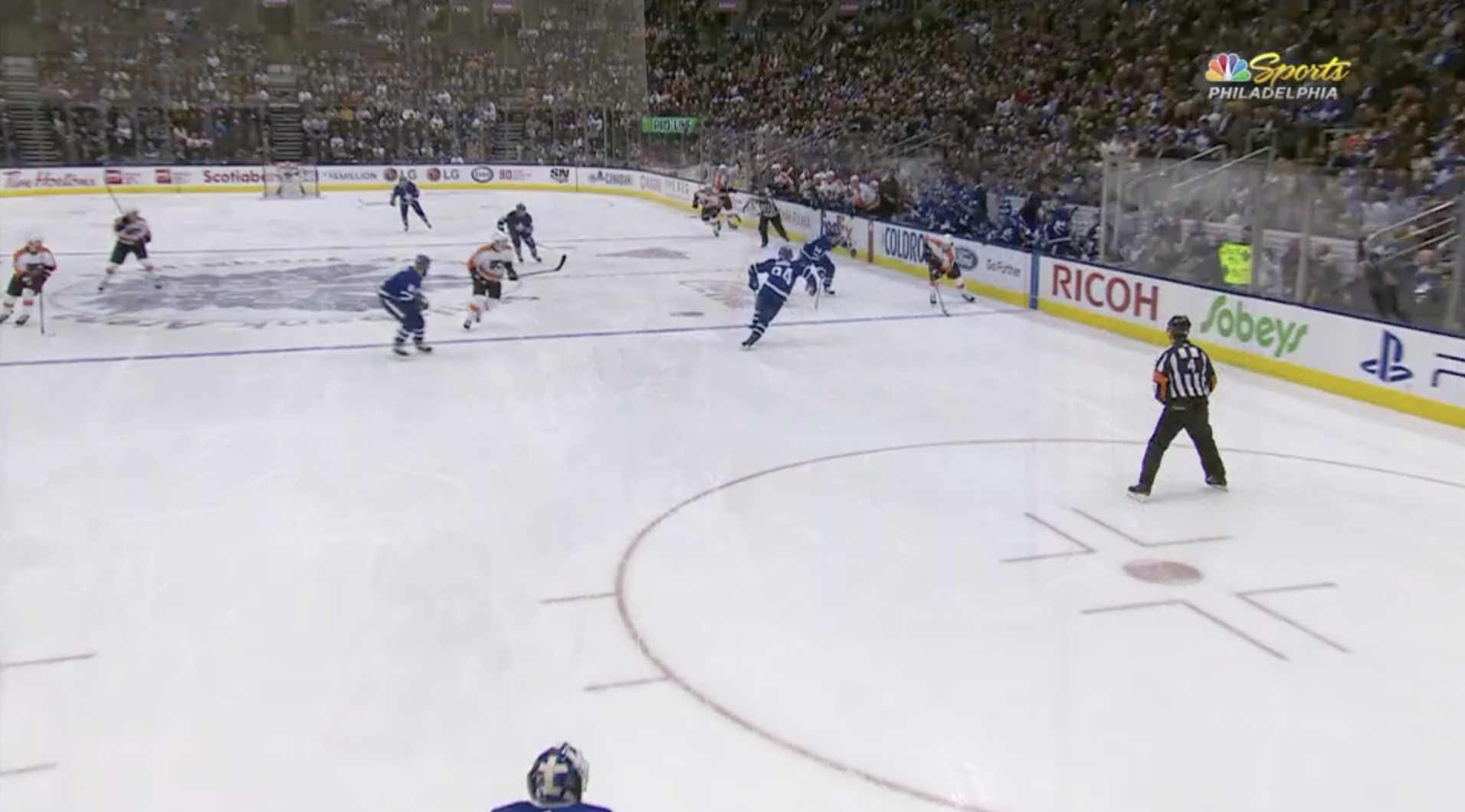
Ultimately, he scores on the play and Johnsson is nowhere near what was always his guy. Instead, he’s desperately lunging at him from a distance.
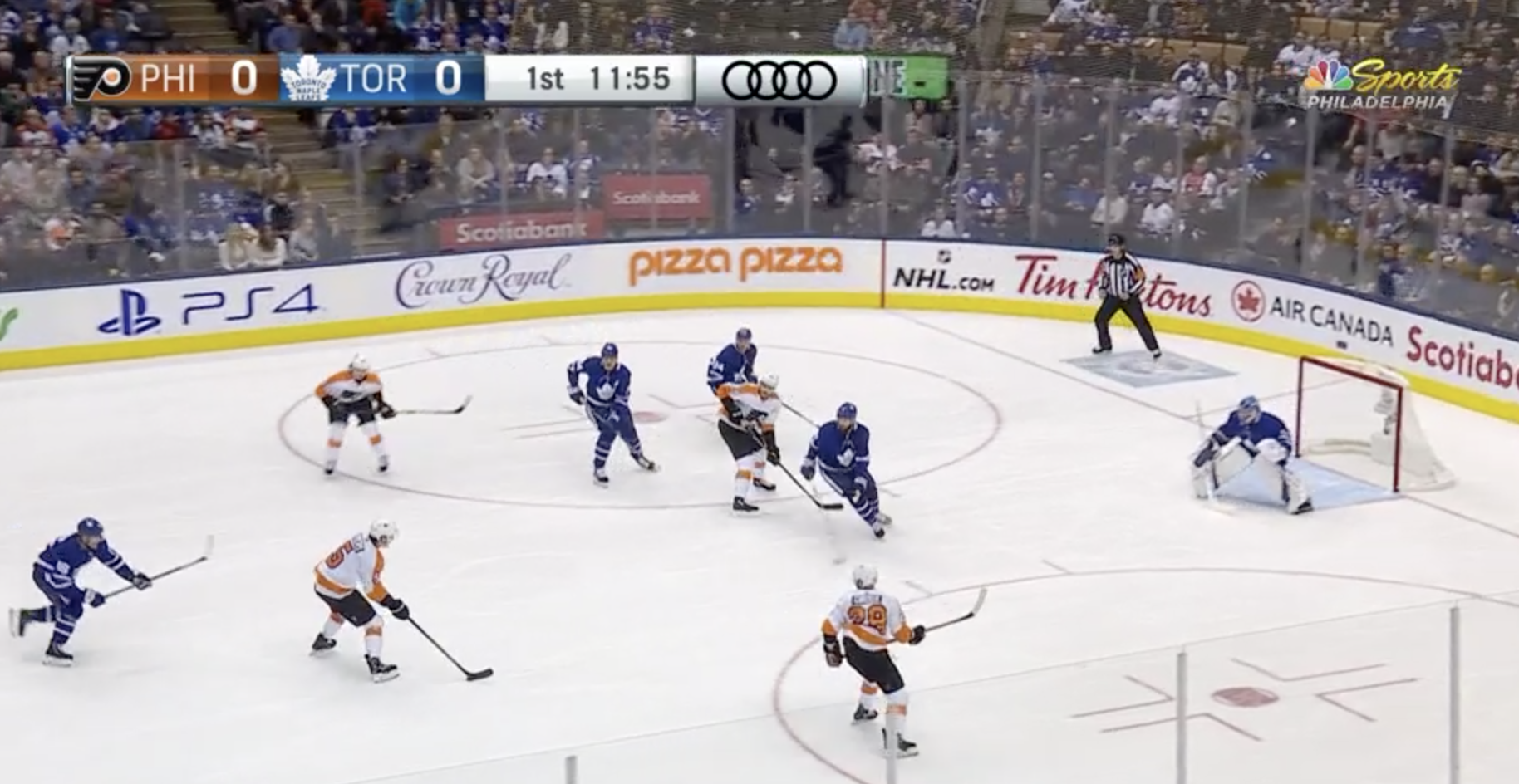
This scenario highlights Johnsson, but it really applies to most Leaf forwards. The funny thing is, the rest of Johnsson’s game that night was fantastic. He helped create the turnover and then the shooting lane for Travis Dermott’s goal. He was involved physically and has embraced his role as the forechecker on that line.
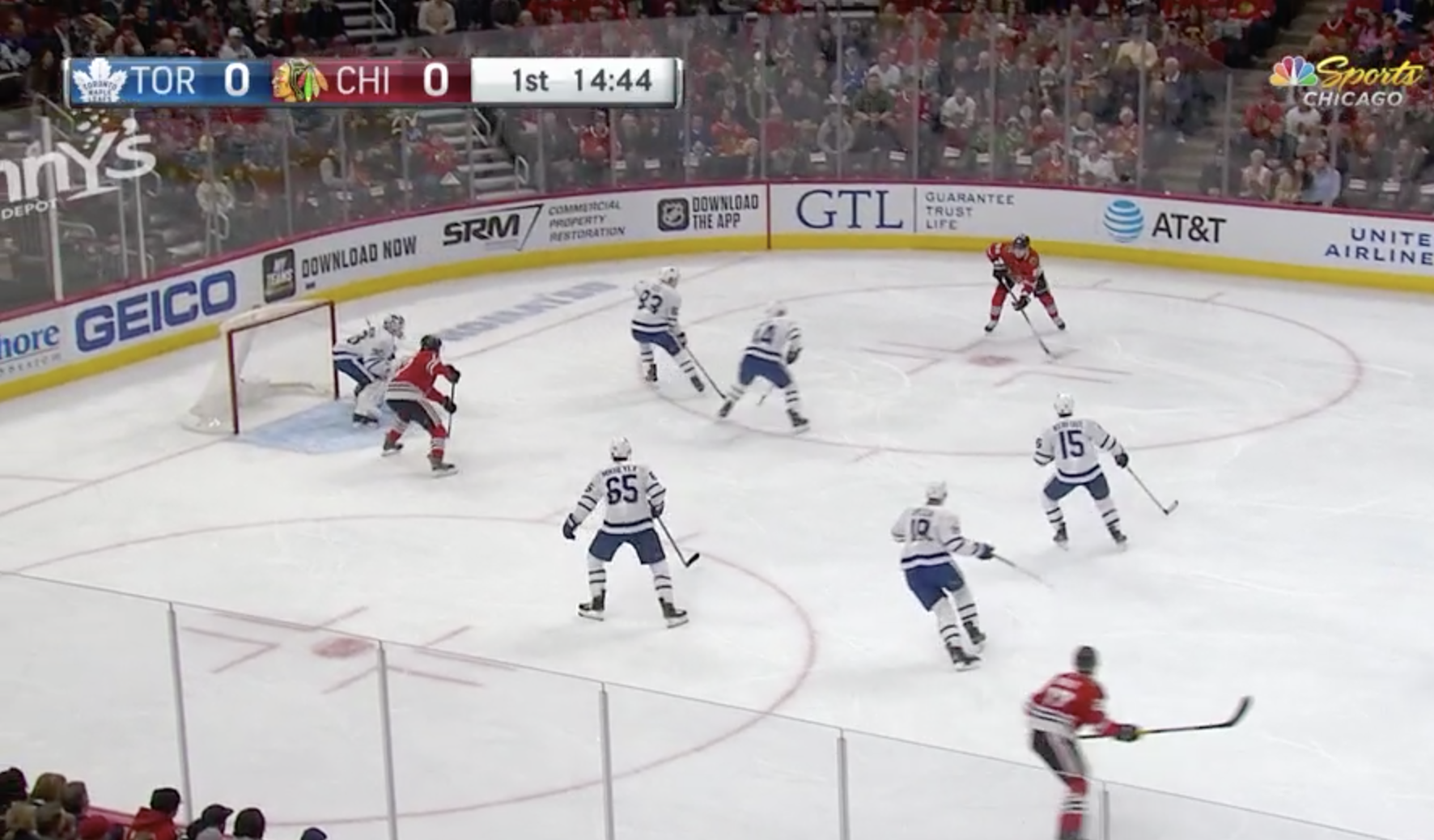
– Of course, the defense group is also just problematic on its own. Morgan Rielly and Cody Ceci didn’t communicate at all for what should have been an easily preventable goal here:

Quotes
“The amount of information available to you now, the biggest thing is you can’t get clouded with too much of it, you’ve still got to coach people … it’s as much fun or more fun now”
– Mike Babcock on the challenge of coaching in today’s NHL
I’ve often wondered about this from a coaching perspective. I don’t think you can overwhelm players with a bunch of stats, but I do think you can focus on a few things with them – where they are shooting from, quality scoring chances for/against, their ability to defend offensive attacks in the neutral zone, and maybe something like breakout percentage. Many of the stats we see used are probably more applicable at the management and decision-making levels — which is fine — but at the coaching level, you need to figure out the more granular things that help you achieve the larger statistical goals.
“With the structure we have, we’re not saying, ‘Don’t jump in,’ but it’s certainly not fully roaming around in the O-zone … I got to join the rush as opposed to leading it which is, I think, a good thing … They’re very different coaches, but both respected & good at their jobs. I think Mike’s a little more, you know, he knows exactly what he wants & how to do it & just trying to figure that out a little bit.”
– Tyson Barrie on adjusting to a new system and coach
“Yesterday I showed a bunch of clips to our coaches of Barrie … jumping by us, creating 3-on-2s, 4-on-3s and they go ‘You showed me that one (already)’ and I go ‘No, that’s a different one.’ There’s too many examples of it”
– Bill Peters on Tyson Barrie in April earlier this year
There’s a disconnect here, and I’m not really sure what Tyson Barrie is talking about, to be honest. He’s saying he needs to join the rush; that was literally what he did for years. You can find a collection of highlights of it on YouTube. I think he’s in his own head a bit right now. He just needs to stop thinking so much and get back to playing hockey.
“We predicted that talent facilitates performance…but only up to a point, after which the benefits of more talent will decrease and eventually turn negative as intra-team coordination suffers. We also predicted that the level of task interdependence would be a key determinant of when more talent would be detrimental versus beneficial. Three archival studies revealed that the too-much-talent effect only emerged when in tasks where team members were interdependent (football and basketball) but not independent (baseball). Our basketball analysis established the mediating role of team coordination. When teams need to come together, more talent can tear them apart.”
– Part of the abstract of a study titled, The too-much-talent effect: Team interdependence determines when more talent is too much versus not enough
The link above leads to some worthwhile food for thought.
Tweets of the Week
Strangest 9-5-3 start. Inconsistent, injuries, special teams a mess. But…9-5-3.
— Bryan Hayes (@HayesTSN) November 8, 2019
The record is a bit different since this tweet was sent out (the team is 9-6-4), but the general point remains – the negativity surrounding the team is not aligned with their record or even their overall results. They are not playing as well as they should be, without question, but it’s also not a complete disaster. Again, early adversity is good. Every team goes through dips in the course of an 82-game season and this is definitely the time to do it. In the meantime, it’s not as if they are putting themselves in some sort of hole.
"Nylander should be shopped" pic.twitter.com/FiwnTjKYjG
— Sean Tierney (@ChartingHockey) November 6, 2019
A theory I’ve been contemplating the last few weeks: Is William Nylander the new Alex Semin? Analytics darling that general fans seem to loathe? It’s not a perfect comparison, but the dots sort of connect. In any case, he’s a good complement for Matthews. Without Nylander, I don’t actually love their other winger options to ride shotgun with Matthews, who was really frustrated playing alongside Kapanen last season.
At the same time, I recognize that if the team just goes through the motions all season and loses in the first round again, a shoe will have to drop at some point. Not saying it should be Nylander, but eventually, the core is going to come into question here.
Brian Lashoff delivered a high hit to Marlies defenseman Timothy Liljegren tonight which led to this scuffle. pic.twitter.com/qv3lFQPQ13
— Zach Harig (@FOX17Zach) November 10, 2019
This is an awful hit. I hope Timothy Liljegren has a full recovery. He is a promising prospect, but he has to play even 45 games during a regular season through his first two full AHL seasons. At least he played in every playoff game both years (20 the first year, 13 the next), but you have to wonder how much missing so many games will impact his development. Liljegren is an all-situations defender in the league, but he hasn’t exactly lit the world on fire — although he is still only 20 years of age. It would be fair to say at this point that Rasmus Sandin has passed him on the depth chart when Liljegren should actually have the advantage just by virtue of being right-handed in this organization.
5 Things I Think I’d Do
1. I think I would be strongly considering moving John Tavares back in front of the net while putting Andreas Johnsson in the bumper role on the power play. You make more of an impact in front of the net, where Tavares was really good last year. We’ve also seen Johnsson sporadically in the bumper role and he’s serviceable in that spot – you don’t need anything more than that.
The power play also needs to run completely through Matthews on the wall. Their best weapons are his shot and the damage Tavares can do in front of the net. Anything else that opens up is the result of teams over-committing on those two elements. Right now, I have no idea what they are trying to set up on the power play.
2. While I understand the pining for Tyson Barrie to be on PP1, I think I wouldn’t do it yet because, 1) he hasn’t earned it this season, and 2) I don’t think Morgan Rielly is the issue with PP1. Barrie has struggled and it just isn’t the right message among a group of players to reward one for struggling while dropping a player that has been far more productive since the start of last season. While teams sag off Rielly on the power play, the Leafs are putting the puck on Matthews’ side more anyway, so teams can sag off Barrie, too – as a righty, he can’t one-time that puck. While I wrote earlier that I would put Barrie on PP1, I think it only makes sense to do so while running it through Marner on the other side — that way, you can set Barrie up for one-timers.
3. When Zach Hyman returns, I think this is what I would do (although I do not think the Leafs will do this): Keep the Matthews line together (which they will do), then put Mikheyev with Tavares and Hyman, and Moore with Kerfoot and Kapanen. For now, I would just keep the fourth line as is, that said…
4. While I understand the Travis Dermott hype and why fans want to see him in the top four, I also think I understand pumping the brakes. Last season, when the Leafs tried giving him more responsibility, he struggled down the stretch.
I
Against the Blackhawks, his aggression in the neutral showed up on the bad side of things – the goal that made it 5-3 opened up when Dermott needlessly lunged out to the puck carrier skating along the wall. He made a simple pass through Dermott, creating a quick 2v1 for a goal. That should be a simple read at this point for Dermott.
Earlier in the game, he sagged off Patrick Kane after stepping up on him in the neutral zone. Kane walked right in for a goal — based on the sequence of events, that was in fact Dermott’s man. Now, everyone gets burned and just above I showed a screenshot of Rielly and Ceci looking particularly bad, but I think they want Dermott to iron this stuff out before moving full-time in the top four instead of bouncing him around.
5. I think that was a commendable effort from the Leafs against Chicago after being down big, early, on the second half of a back-to-back. Teams that have quit on the coach don’t do that.


![Jim Montgomery Post Game, Bruins 4 vs. Leafs 2: “[Marchand] still manages to get under people’s skin, yet he doesn’t cross the line” Jim Montgomery, Boston Bruins post game](https://mapleleafshotstove.com/wp-content/uploads/2024/04/jim-monty-pg-to-218x150.jpg)
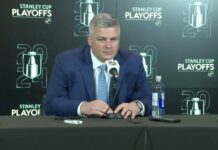





















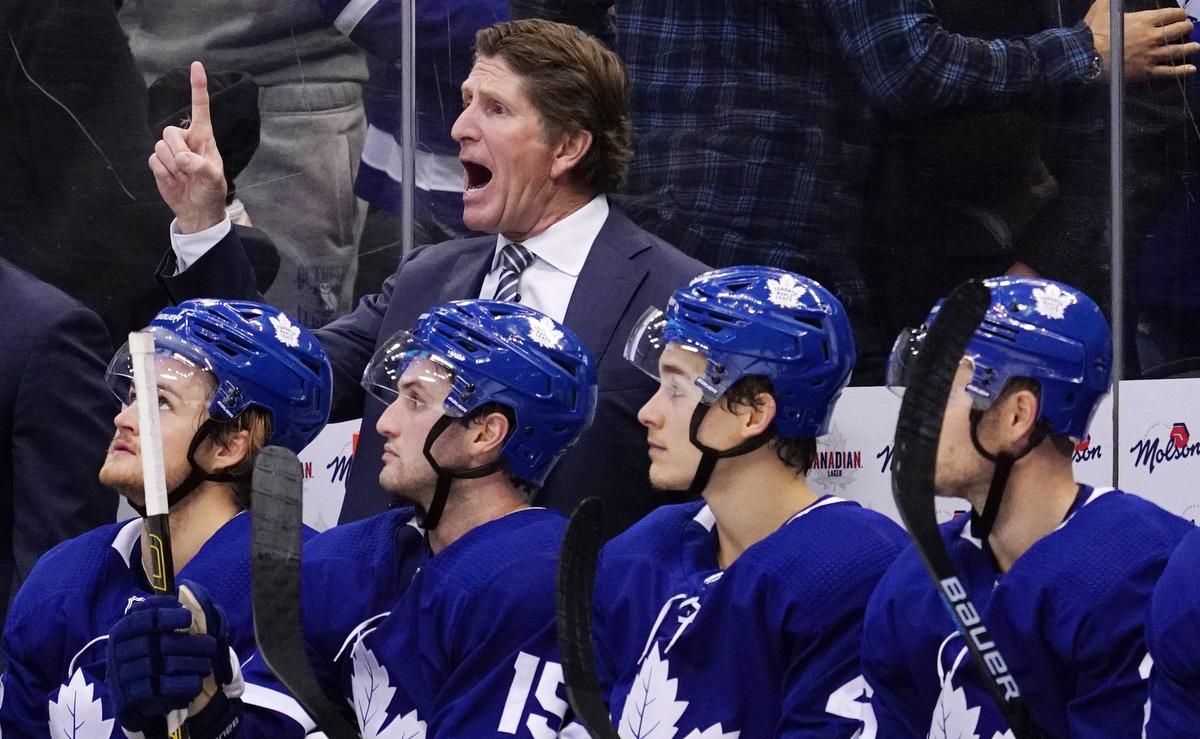



![Jim Montgomery Post Game, Bruins 4 vs. Leafs 2: “[Marchand] still manages to get under people’s skin, yet he doesn’t cross the line” Jim Montgomery, Boston Bruins post game](https://mapleleafshotstove.com/wp-content/uploads/2024/04/jim-monty-pg-to-100x70.jpg)







